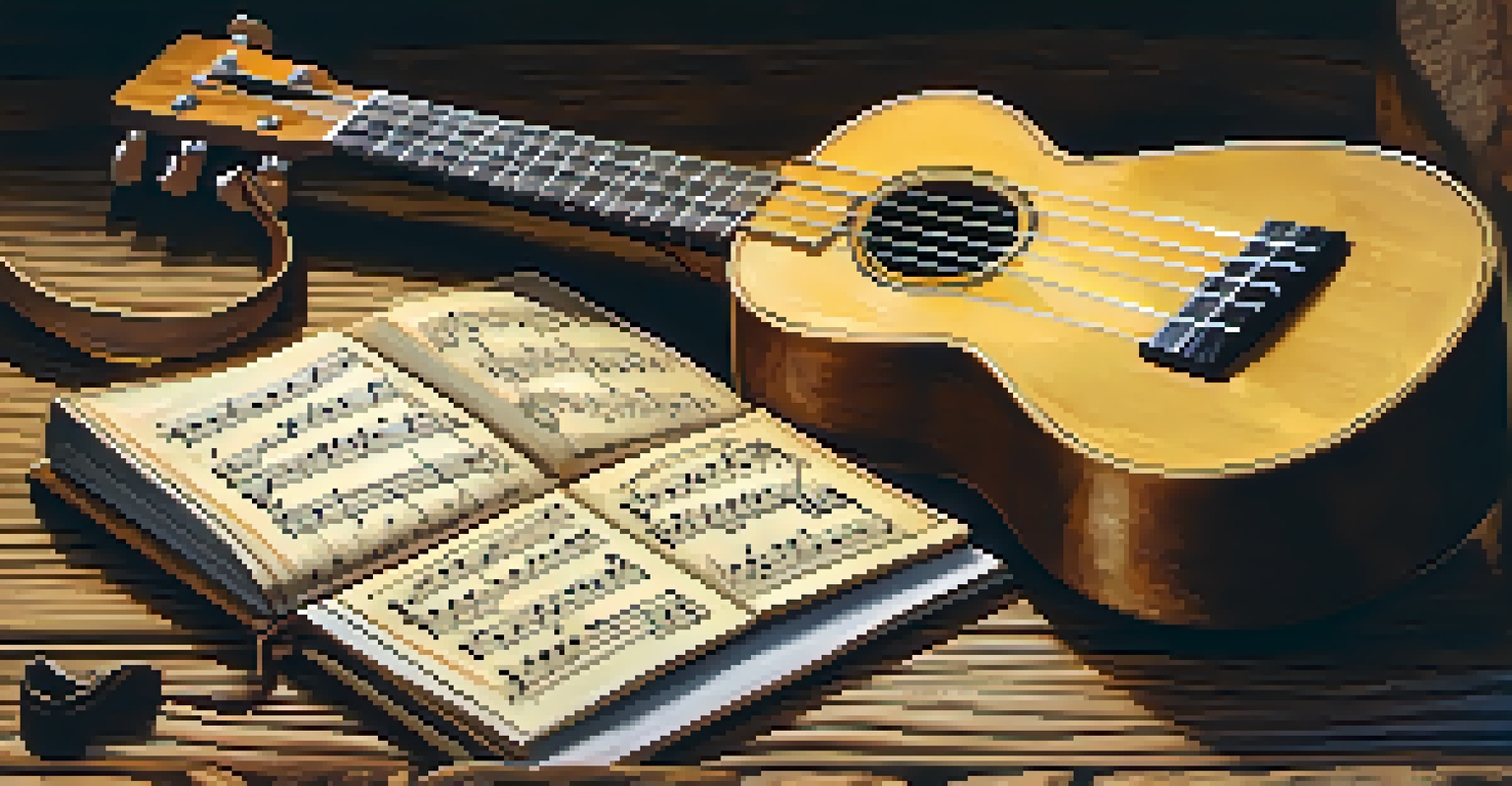How to Train Your Ear for Playing Ukulele Without Notation

Understanding the Basics of Ear Training
Ear training is the process of developing your ability to identify notes, chords, and rhythms by hearing them. This skill is essential for musicians, especially for those who want to play by ear. Unlike reading notation, which can sometimes feel rigid, ear training allows for a more intuitive and personal approach to music.
Music is the shorthand of emotion.
When you train your ear, you're essentially sharpening your musical instincts. This will help you recognize melodies and harmonies just by listening, making your ukulele playing much more enjoyable. Imagine being able to pick up a song you love simply by hearing it—now that's powerful!
Remember, ear training is a gradual process, and consistency is key. Just like learning a new language, it takes time to become fluent. Embrace the journey and be patient with yourself as you develop this valuable skill.
Listening Actively to Music
Active listening involves paying close attention to the music you enjoy, rather than letting it play in the background. Start by focusing on individual instruments or vocals in a song, and try to follow their melodies. This practice will enhance your ability to discern different musical elements, which is crucial for playing the ukulele without notation.

You can also listen for patterns in music. Many songs follow similar chord progressions or melodies, and recognizing these patterns will help you play by ear. For instance, if you notice that a lot of pop songs use the same four chords, you can practice those chords until they become second nature.
Ear Training Enhances Musical Skills
Developing your ear helps you identify notes, chords, and rhythms, making playing by ear more intuitive and enjoyable.
To make this process more engaging, consider creating playlists of songs you want to learn. As you listen, hum or sing along with the melodies. This not only reinforces your ear training but also makes the experience more enjoyable as you immerse yourself in the music.
Using the Ukulele to Explore Sounds
Your ukulele is a fantastic tool for ear training. Start by playing around with different notes and chords, trying to replicate what you hear in songs. This hands-on approach allows you to connect sounds to the physical act of playing, making it easier to remember and recognize them later.
The ear is the avenue to the heart.
Try to play simple melodies by ear. Start with familiar tunes like nursery rhymes or folk songs, as they often have straightforward melodies that are easier to pick up. As you gain confidence, gradually challenge yourself with more complex pieces.
Keep in mind that it’s okay to make mistakes! Each wrong note is a learning opportunity that brings you closer to mastering the song. Enjoy the process of experimenting with sounds and discovering how they fit together on your ukulele.
Singing to Develop Your Musical Ear
Singing is one of the best ways to train your ear, as it forces you to rely on your vocal cords to reproduce what you hear. Even if you're not a confident singer, don't shy away from trying it! By singing along with your favorite songs or melodies, you enhance your ability to recognize pitches and intervals.
You can also practice singing scales or simple melodies without any accompaniment. This helps solidify your understanding of how notes relate to one another. It’s like building a mental map of music, which will prove invaluable when you pick up your ukulele.
Active Listening Improves Recognition
Focusing on individual instruments and patterns in music enhances your ability to discern musical elements crucial for playing the ukulele.
If you’re unsure where to start, consider using a piano or a tuning app to help you find the correct pitches. Once you’ve identified the notes, sing them out loud. This reinforces your connection to the sound and improves your overall musicality.
Identifying Intervals and Chords by Ear
Intervals are the building blocks of music, defining the distance between two notes. Start by familiarizing yourself with common intervals, such as major seconds or perfect fifths. You can practice identifying these intervals by listening to songs and trying to reproduce them on your ukulele.
Chords can also be identified by ear. Listen for the distinct sound of major and minor chords, as they evoke different emotions. For instance, major chords often sound happy and bright, while minor chords can feel more somber or reflective. The more you listen, the easier it will be to distinguish between them.
A great exercise is to play a chord on your ukulele and then try to find a song that uses that same chord. This not only helps with recognition but also reinforces your understanding of how chords function in different musical contexts.
Using Technology to Aid Ear Training
In today’s digital age, there are countless apps and online resources designed to help musicians train their ears. Look for apps that focus on interval recognition, chord identification, or even ear training games. These tools can make learning fun and interactive while providing valuable feedback.
YouTube is another treasure trove of ear training resources. Many musicians share tutorials that emphasize playing by ear, often breaking down songs into manageable sections. Watching these videos can inspire you and offer new perspectives on familiar tunes.
Create Music for Deeper Understanding
Composing your own melodies and chord progressions reinforces your ear training by deepening your grasp of how notes and chords interact.
Don’t forget about recording yourself! By playing and singing along to your favorite songs, you can listen back to identify areas for improvement. This self-assessment is a powerful tool for ear training and helps you track your progress over time.
Creating Your Own Music to Practice Ear Training
One of the best ways to solidify your ear training is to start composing your own music. This doesn’t mean you need to write a symphony; even simple melodies or chord progressions can help you understand musical structure. By creating music, you're forced to think about how notes and chords interact, deepening your understanding of sound.
Experiment with different styles and genres. You might find that certain chord progressions inspire you more than others. For example, writing a catchy pop tune might lead you to explore major chords, while a more melancholic piece could draw you toward minors.

As you create, don’t hesitate to share your music with friends or fellow ukulele players. Receiving feedback can be invaluable, and discussing your musical choices can help you refine your ear training even further.